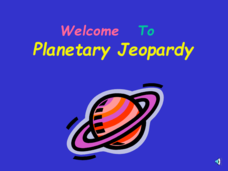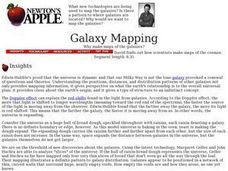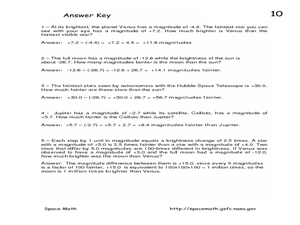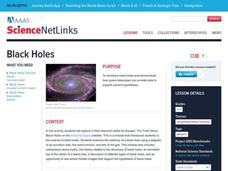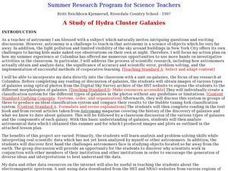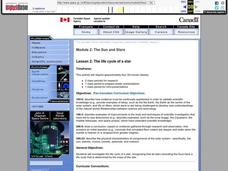Curated OER
Planetary Jeopardy!
Space Science can be so much fun, especially when you play Planetary Jeopardy! This game tests students on what they know about Roman Gods, the planets and moons in our solar system, and the Earth's rotation.
NASA
Space-Based Astronomy on the Internet
Young scientists compile everything they have learned into a report in the fifth and final lesson in a unit on the visible light spectrum. Access to photos from observatories, telescopes, and satellites allows learners to compare and...
Messenger Education
Mission: Possible—How Can We Plan an Exploration of Another World?
An astronaut's spacesuit weighs 280 pounds and takes 45 minutes to put on — that's a serious suit! The second activity of a three-part series allows pupils to see all that goes into space exploration. Through simulations, groups analyze...
University of Colorado
Phases of Charon
Pluto, although no longer considered a planet, has five moons. Pluto's moon, Charon, is the focus of a resource that describes how the moon is viewed from the surface of Pluto. Photos help individuals see how Charon would look at...
Research Parent
Solar System Cards
Find all things solar system in a set of reference cards. Even Pluto makes an appearance! Each of the 24 cards has a picture and accompanying informational text that gives brief background about the object.
Glynn County School System
Other Galaxies
The Milky Way belongs to a cluster of galaxies called the local group and it could be considered our neighborhood! Use the PowerPoint to present information on the different galaxy types, both local and farther away. Scholars learn how...
American Museum of Natural History
Planetary Mysteries
Get to know our little part of the vast universe. Learners read about the common and not-so-common facts about each of the planets in the solar system. The interactive lesson includes a large amount of information as well as a quiz to...
Curated OER
Stellar Fingerprints: the Spectra of Stars
Students explain how an element can be identified using emission spectra. They relate the emission spectrum of hydrogen to its absorption spectrum and identify hydrogen absorption lines in the spectrum of stars.
Curated OER
Volcanoes in Space
Young scholars research volcanoes on the Internet to compare/contrast the volcanoes on Earth to the ones found on Io, a moon of Jupiter. Students list the similarities and differences in science journals, and illustrate pictures of the...
Curated OER
Missouri Alphabetizing Worksheet
In this Missouri worksheet, students read 12 words in a list that pertain to the state of Missouri. Students alphabetize the words.
University of Colorado
Phases of Charon
Charon, the largest of Pluto's moons, was discovered in 1978. Lesson is a walk through of how to solve for the phases of Charon. It uses two different points on Pluto and takes into account the tilt of the pole, the rotational axis, and...
American Museum of Natural History
A Closer Look at Mars
A website looks at how we know so much about Mars—telescopes, robots, and spacecraft—and the search for martian life. Following the informational text are three questions that quiz pupils about possible life on Mars.
Curated OER
Black Holes Revealed
Learners explore the concept of black holes through an interactive program. They explore how they form and what materials form them. They can also visit websites in which they can research radio transmission between the Earth and space.
Curated OER
Galaxy Mapping
Young scholars research the constellations and discuss their findings. Then they construct their own maps of the galaxy using paper, black paint, aluminum foil, etc. They make a 3-D map of their chosen constellation.
Curated OER
How Many Stars in the Milky Way?
Students perform an experiment in which they will use a statistical method called `sampling' to count to a billion (and beyond). Students practice sampling by estimating the number of characters on a page from the classified section of a...
Curated OER
The Stellar Magnitude Scale
In this stellar magnitude scale instructional activity, students use a scale showing the magnitude of objects in the sky to answer 5 questions about the brightness of the moon, the planets and stars.
Curated OER
Eagle Nebula - Close-up
In this Eagle nebula worksheet, students solve 4 problems including finding the size of the nebula field, determining the scale of the image, determining how large the nebula is in millimeters and determining the size of the smallest...
Curated OER
Power Functions: A Question of Magnitude
For this power functions worksheet, students read about determining the brightness of stars using a magnitude scale. Students solve 4 problems including finding the magnitude differences of stars and determining equivalent magnitudes.
Curated OER
A Distant View
Students investigate the essential concepts of how lenses work to magnify vision, and then build simple telescopes to demonstrate their understanding. They write a description of how their telescope could be improved and how it works.
Curated OER
Black Holes
Students study black holes and see how space telescopes can provide data to support current hypotheses. They examine the anatomy of a black hole using a diagram of an accretion disk, the event horizon, and jets of hot gas.
Curated OER
Life Cycle Of Stars
Students analyze characteristics that indicate human life cycles, and then apply these observational principles to various NASA pictures of stars to synthesize patterns of stellar life cycles. They observe NASA images of stars at various...
Curated OER
A Study of Hydra Cluster Galaxies
Students analyze a designated galaxy with a partner or in a small group.
Curated OER
The Life Cycle of a Star
Students investigate the life cycle of a star through research. Once research is complete, students prepare posters and present findings to class. Flash animation is included to help students visualize life cycle of star researching.
Curated OER
The Universe
Young scholars describe what scientists mean by an "expanding universe" in their own words. They explain how scientists comprehend the universie is expanding. Students comprehend the vast scale of the universe. They comprehend how...
Other popular searches
- Edwin Hubble
- Hubble Space Telescope
- Hubble Telescope Webquest
- Hubble Telescope Web Quest
- Hubble Spcae Telescope
- Hubble Telescope Activity
- Hubble Telescope Information
- Hubble Telescope Graphs
- Hubble Telescope Lesson Plan
- Hubble Telescope Technology
- Hubble's Law
- Hubble Telescope Deep Space


